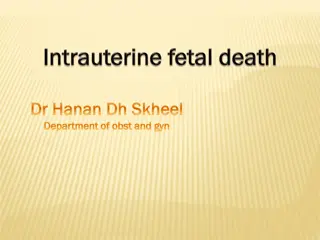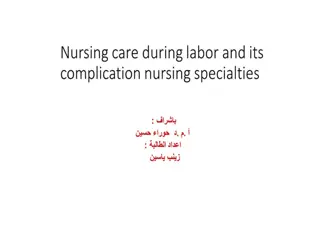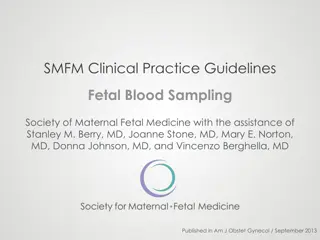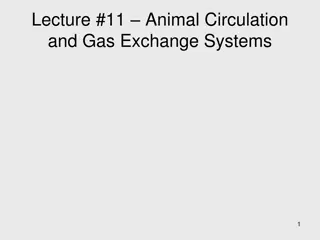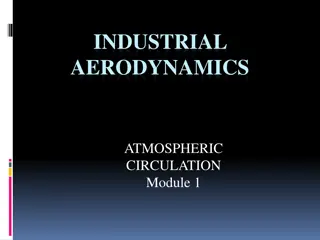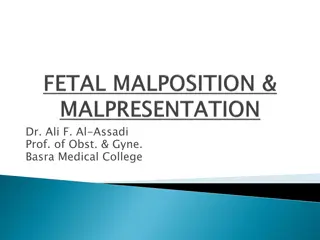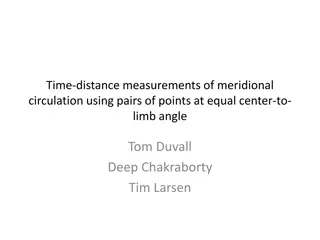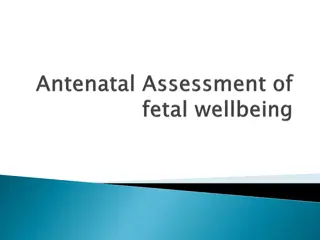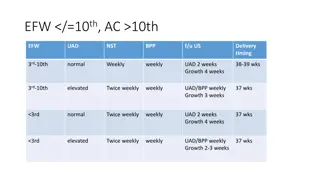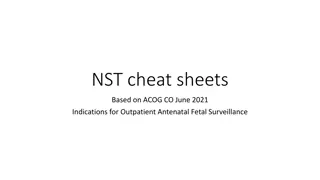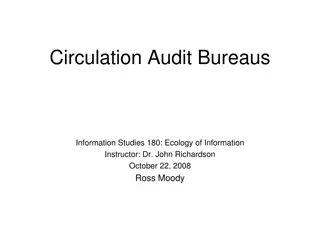Fetal Circulation
Fetal circulation involves intricate pathways that support oxygen exchange and nutrient delivery from the placenta to the developing fetus. Key structures like the umbilical vein, ductus venosus, and foramen ovale play crucial roles in directing blood flow. Understanding these mechanisms is essential for comprehending the unique physiology of fetal circulation.
Download Presentation

Please find below an Image/Link to download the presentation.
The content on the website is provided AS IS for your information and personal use only. It may not be sold, licensed, or shared on other websites without obtaining consent from the author.If you encounter any issues during the download, it is possible that the publisher has removed the file from their server.
You are allowed to download the files provided on this website for personal or commercial use, subject to the condition that they are used lawfully. All files are the property of their respective owners.
The content on the website is provided AS IS for your information and personal use only. It may not be sold, licensed, or shared on other websites without obtaining consent from the author.
E N D
Presentation Transcript
Fetal Circulation Ms.Ashwini.S.Mane
Anatomy and Physiology Fetal Circulation Umbilical cord 2 umbilical arteries: return non-oxygenated blood, fecal waste, CO2 to placenta 1umbilical vein: brings oxygenated blood and nutrients to the fetus
Fetus depends on placenta to meet O2 needs while organs continue formation Oxygenated blood flows from the placenta To the fetus via the umbilical vein After reaching fetus the blood flows through the inferior vena cava
The differences between fetal and newborn circulation The fetus received oxygen from the placenta and through the lungs after birth. The fetal liver doesn t have the metabolic function that it will have after birth because the mother performs these functions. Three shunts are present in fetal life: 1. Ductus venosus: connects the umbilical vein to the inferior vena cava 2. Ductus arteriosus: connects the main pulmonary artery to the aorta 3. Foramen ovale: anatomic opening between the right and left atrium.
The umbilical vein carrying the oxygenated blood (80% saturated) from the placenta , enters the fetus at the umbilicus and run along the free margins of the falciform ligaments of the liver , in the liver , it gives off branches to the lobe of the liver and receives the deoxygenated blood from the portal vein The greater portion of the oxygenated blood , mixed with some portal venous blood , short circuits the liver through the ductus venous to enter the inferior vena cava and then to right atrium of the heart
The O2 content of this mixed blood is thus reduced , although both the ductus venous and hepatic portal/fetal trunk blood enters the right atrium through the inferior vana cava, there is a little mixing The terminal part of the IVC receives blood from the right hepatic vein
In the right atrium , most of the well oxygenated (75%) ductus venous blood is preferentially directed into the foramen ovale by the valve of the inferior vana cava and crista dividens and passes in to the left atrium , here it is mixed with small amount of venous blood returning from the lungs through the pulmonary veins The left atrial blood is passed on through the mitral opening into the left ventricle
Remaining the lesser amount of the blood (25%), after reaching the right atrium via the superior and inferior vena cava (carrying the venous blood from the cephalic and caudal parts of the fetus respectively) passes through the tricuspid opening into the right ventricle
During the ventricular systole , the left ventricular blood is pumped into the ascending and arch of aorta and distributed by their branches to heart , neck , brain and arms The right ventricular blood with low oxygen content is discharged into the pulmonary trunk , sinces the resistance in the pulmonary arteries during fetal life is very high , the main portion of the blood passes directly through the ductus arteriosus into the descending aorta bypassing the lungs where it mixes with the blood from the proximal aorta
70% of cardiac output is carried out by ductus arteriosus to the descending aorta About 40% of the combined output goes to the placenta through the umbilical arteries
The deoxygenated blood leaves the body by of two umbilical arterie s to reach the placenta where it is oxygenated and get ready for recirculation The mean cardiac output is comparatively high in fetus and is estimated to be 350ml per kg per minute
Conversion of Fetal to Infant Circulation At birth Clamping the cord shuts down low-pressure system Increased atmospheric pressure(increased systemic vascular resistance) causes lungs to inflate with oxygen Lungs now become a low-pressure system
Conversion: Fetal to Infant Circulation Pressure from increased blood flow in the left side of the heart causes the foramen ovale to close More heavily oxygenated blood passing by the ductus arteriosus causes it constrict Functional closure of the foramen ovale and ductus arteriosus occurs soon after birth Overall anatomic changes are not complete for weeks
What happens to these special structures after birth? Umbilical arteries atrophy Umbilical vein becomes part of the fibrous support ligament for the liver The foramen ovale, ductus arteriosus, ductus venosus atrophy and become fibrous ligaments
Overview of Conversion Umbilical cord is clamped Loose placenta Closure of ductus venosus Blood is transported to liver and portal system Increased systemic resistance Pressure in right atrium decreased Change from right to left shunting to left to right blood flow Increased O2 levels in pulmonary circulation Closure of the ductus arteriosus



